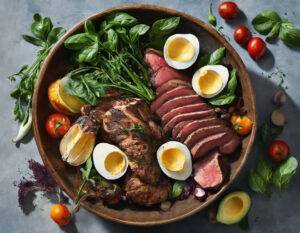Health trends come and go, but one thing remains constant: Americans are always on the lookout for the next big thing to improve their well-being. From millennials to baby boomers, each age group has its own set of health fads that capture their attention. In this blog post, we will delve into the fascinating world of health-related trends among Americans of various age groups. We will examine the good and the bad aspects while sprinkling in a dash of humor. So, fasten your seatbelts and get ready for an informative and entertaining journey!
The Ever-Evolving Health Trends: A Comprehensive Look at America’s Health Fads
Just a little heads up: some of the links on this site may be affiliate links, which means if you make a purchase through them, we might get a little kickback. But don’t worry, it won’t cost you a cent extra! Think of it as the universe secretly thanking us for helping you find a great deal. Your support keeps the good vibes flowing.
Health Fad #1: Intermittent Fasting
One health trend that has taken the nation by storm is intermittent fasting. This approach involves cycling between periods of fasting and eating. Supporters claim that it aids weight loss, improves insulin sensitivity, and has other health benefits. However, it’s important to approach intermittent fasting with caution. While some individuals may see positive results, it may not be suitable for everyone, especially those with underlying medical conditions. [Source: www.healthline.com/nutrition/intermittent-fasting-guide]
Health Fad #2: Plant-Based Diets
Another health fad gaining popularity is the adoption of plant-based diets. Plant-based eating emphasizes fruits, vegetables, whole grains, and legumes while reducing or eliminating animal products. This dietary approach may offer numerous health benefits such as reducing the risk of heart disease and promoting weight loss. However, it’s crucial to ensure adequate nutrient intake, especially for essential vitamins like B12 and minerals like iron. [Source: www.nutrition.org/healthy-eating/plant-based-diets]
Health Fad #3: High-Intensity Interval Training (HIIT)
When it comes to exercise, high-intensity interval training (HIIT) has become a go-to workout for many. HIIT involves short bursts of intense exercise followed by brief recovery periods. This form of exercise is time-efficient, helps burn calories, and improves cardiovascular health. However, it can be physically demanding and may not be suitable for everyone, particularly individuals with certain health conditions. Moderation and listening to your body are key. [Source: www.acsm.org/read-research/trending-topics-resource-pages/high-intensity-interval-training]
Health Fad #4: Essential Oils
Essential oils have also gained popularity as a natural remedy for various ailments. These concentrated extracts from plants are often used in aromatherapy or applied topically. While some essential oils have documented benefits, others lack scientific evidence to support their claims. Proper use, dilution, and understanding potential risks are essential when incorporating essential oils into your wellness routine. [Source: www.nih.gov/news-events/nih-research-matters/essential-oils-science]
Health Fad #5: Meditation and Mindfulness
Amid the hustle and bustle of modern life, many Americans have turned to practices like meditation and mindfulness to achieve mental wellness. Meditation involves focusing the mind and achieving a state of calm, while mindfulness encourages being fully present in the moment. These practices have been linked to reducing stress, improving sleep quality, and promoting overall well-being. Integrating meditation and mindfulness into daily routines may offer numerous benefits, but it requires dedication and consistency. [Source: www.mayoclinic.org/tests-procedures/meditation/in-depth/meditation/art-20045858]
Health Fad #6: Gut Health and Probiotics
The importance of gut health has gained significant attention recently, with many Americans focusing on maintaining a healthy gut microbiome. Probiotics, live bacteria, and yeasts are commonly consumed through fermented foods or supplements to support gut health. Research suggests that a balanced gut microbiome is crucial for immune function, digestion, and overall health. While probiotics can offer potential benefits, individual responses may vary, and it’s important to choose reputable sources and consult healthcare professionals before incorporating them into your dietary routine. [Source: www.ncbi.nlm.nih.gov/pmc/articles/PMC6463098/]
Health Fad #7: CBD Products
The rise of CBD (cannabidiol) products has piqued the interest of many seeking natural alternatives for relaxation and relief. CBD, derived from the cannabis plant, is non-psychoactive and claimed to have therapeutic properties. Some studies suggest it may help alleviate symptoms related to anxiety, chronic pain, and insomnia. However, CBD’s regulatory status and scientific evidence are still evolving, and it’s essential to consult with experts and adhere to local laws and regulations before using CBD products. [Source: www.health.harvard.edu/blog/cannabidiol-cbd-what-we-know-and-what-we-dont-2018082414476]
Sources:
- Intermittent Fasting Guide – Healthline
- Plant-Based Diets – The American Society for Nutrition
- High-Intensity Interval Training – American College of Sports Medicine
- Essential Oils Science – National Institutes of Health (NIH)
- Meditation – Mayo Clinic
- Gut Health and Probiotics – National Center for Biotechnology Information (NCBI)
- CBD Products – Harvard Health Blog
Health Fad #8: Wearable Fitness Technology
In the age of technology, wearable fitness devices have become a popular trend for health-conscious Americans. These devices, ranging from smartwatches to fitness trackers, provide individuals with real-time data about their physical activity, heart rate, sleep patterns, and more. By tracking their fitness progress, users can set goals, monitor their performance, and stay motivated to lead an active lifestyle. While wearable fitness technology offers convenience and data-driven insights, it’s important to remember that these devices are tools, and true fitness is achieved through consistent effort and a holistic approach to health.
Health Fad #9: Superfood Mania
Superfoods have taken the health arena by storm, captivating Americans with their supposed extraordinary health benefits. From açai berries to kale and chia seeds, these nutrient-dense foods are hailed as natural powerhouses packed with vitamins, antioxidants, and minerals. Many believe that incorporating superfoods into their diet can help boost immunity, enhance energy levels, and improve overall well-being. However, it’s important to note that while superfoods can be part of a balanced diet, there’s no single magical food that can solve all health woes. Variety, moderation, and overall dietary patterns play a crucial role in achieving a sustainable and healthy lifestyle.
Health Fad #10: Intuitive Eating
Breaking away from traditional diets and restrictive eating patterns, intuitive eating is gaining traction as a more holistic approach to nourishing the body. This practice emphasizes listening to the body’s cues of hunger and fullness and developing a positive relationship with food. Intuitive eaters focus on mindful eating, embracing all foods without guilt or judgment, and finding joy in the act of eating. By fostering a healthy mindset and tuning into their body’s needs, individuals can develop a sustainable and balanced relationship with food that promotes overall well-being. However, it’s important to note that intuitive eating may not be suitable for everyone, and individualized guidance from a registered dietitian can be beneficial.
In this blog post, we’ve covered a range of health fads that have grabbed the attention of Americans. From wearable fitness technology to superfoods and intuitive eating, these trends reflect the constant pursuit of better health and well-being. As with any trend, it’s important to approach them with an open mind, conduct thorough research, and consider individual needs and preferences. Remember, the key to achieving lasting health is finding a balanced approach that works best for you and incorporating habits that support your overall well-being.
Sources:
- Wearable Fitness Technology – American Council on Exercise (ACE)
- Superfoods and Health – Academy of Nutrition and Dietetics
- Intuitive Eating – Health at Every Size (HAES) Community
While I do cite reputable sources, I am not a medical professional. Please use professional medical advice when making any health-related decisions.
Conclusion:
As Americans strive for optimal health, they are continuously drawn to new health fads promising remarkable results. We’ve explored several trends that have captured the attention of different age groups. Whether it’s intermittent fasting, plant-based diets, HIIT workouts, or essential oils, these fads have their merits and limitations. Remember, what works for one person might not work for another. Understanding your own body, consulting professionals, and approaching trends with a critical eye are crucial for making informed choices about your health.

Just a little heads up: some of the links on this site may be affiliate links, which means if you make a purchase through them, we might get a little kickback. But don’t worry, it won’t cost you a cent extra! Think of it as the universe secretly thanking us for helping you find a great deal. Your support keeps the good vibes flowing.
































































































